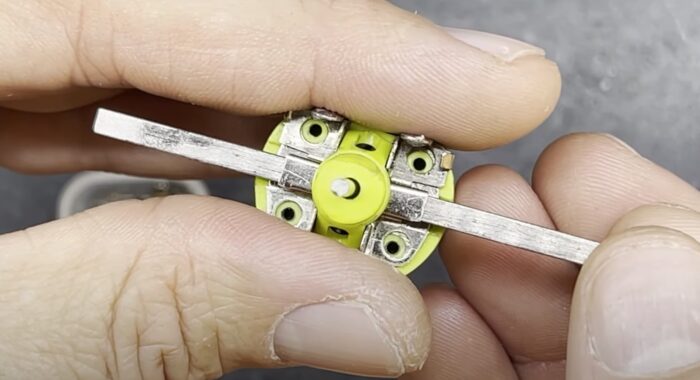Tires and wheels are easily among the most important parts of your slot RC car.
It might seem like paying attention to these is a waste of time but that cannot be farther from the truth.
That is why I would like to share my two cents on what are the most important things you need to know about these.
Table of Contents
Front Wheels Configuration
The configuration of the front wheels plays a significant role in the handling characteristics of a vehicle.
Here’s how it should be done:
Step 1: Assess Current Wheel Setup
Inspect the current diameter of the front wheels to understand the baseline setup. Evaluate the vehicle’s performance on tracks, particularly noting behavior on corners and at high speeds.
Step 2: Choose the Appropriate Wheel Diameter
Select smaller diameter wheels for the front. The size reduction depends on the track requirements and the specific ho slot car model.
Consult with manufacturers or experienced racers to determine the most effective wheel size for your particular type of vehicle and racing conditions.
Step 3: Install the Smaller Front Wheels
Remove the existing front wheels using the appropriate tools, typically a wrench and screwdriver, depending on your vehicle model.
Fit the selected smaller wheels onto the front axle. Ensure they are securely attached and aligned properly.
Step 4: Adjust the Suspension to Accommodate New Wheel Size
Lower the suspension to match the reduced wheel diameter to maintain vehicle balance and aerodynamics.
Check and adjust the camber and toe settings of the wheels to ensure optimal tire contact with the track, improving grip and handling.
Step 5: Test Drive and Fine-Tune
Conduct a test drive on a familiar track to observe the impact of the new configuration under racing conditions.
Monitor handling and stability, particularly in sharp corners and at different speeds. Pay attention to the ease of maneuvering and the tendency of the RC car to stay slotted on the track.
Make further adjustments as necessary, tweaking suspension settings or wheel alignment to achieve the best performance.
Step 6: Regular Maintenance and Checks
Regularly inspect the wheel and suspension setup to ensure everything remains in optimal condition and securely mounted.
Check for wear and tear on the tires and replace them if they show signs of uneven wear or damage to maintain performance and safety.
Step 7: Record and Analyze Performance Data
Keep a log of performance changes and settings adjustments to help in understanding what configurations work best under various conditions.
Use this data to make informed decisions on further modifications or adjustments before each race.
Importance of Rear Tire Grip
The rear tires of a racing vehicle are pivotal for acceleration and maneuvering through corners.
A strong rear tire grip allows for more forceful acceleration out of corners and provides stability when the RC car is at high speeds.
It is essential in racing, where control and speed are tightly interlinked for performance.
Choosing the Right Tire Material
Silicone tires are a popular choice in model ho slot car racing due to their ability to provide a superior grip on the slick surfaces of plastic tracks.
Silicone’s inherent properties allow it to conform better to the track surface, offering increased traction compared to harder materials like rubber or PVC.
Soft vs. Hard Tire Compounds
There are two different tire compounds, soft and hard. Let’s see the pros and cons of both:
| Tire Compound Type | Advantages | Disadvantages |
|---|---|---|
| Soft Compounds |
|
|
| Hard Compounds |
|
|
Tailoring Tire Softness
The softness of the tire compound should be specifically selected based on the type of ho slot car and the racing conditions.
Track Conditions are the following:
- Track material
- Layout
- Surface condition
For instance, a more abrasive track may require a harder compound to reduce wear.
Environmental and Track Conditions Impact
Tire performance is also highly dependent on the track temperature and weather conditions.
For example:
- Warm Conditions: Tires can become softer and provide more grip as they heat up, which can be advantageous in cooler weather but might lead to quicker degradation in hot conditions.
- Wet Conditions: Special compounds or tread patterns might be necessary to handle slick conditions effectively.
Physical Characteristics of the Track
The texture and consistency of the track surface play critical roles in how tires perform.
Smooth surfaces generally require tires with more grip, while rougher textures might benefit from harder compounds that resist wear.
Wheel and Tyre Height Adjustments
Adjusting the height of wheels and tires is a crucial component in the intricate art of race RC car tuning, impacting both performance and strategy.
The adjustment influences the magnetic downforce—a force that enhances the stability and adherence of the car to the track, particularly critical in slot RC car racing.
Impact on Magnetic Downforce
Magnetic downforce is used in slot car racing to keep the vehicle firmly on the track, especially at high speeds and during aggressive maneuvers.
Through adjusting the height of the wheels and tires, racers can control the amount of downforce exerted on the car.
A lower wheel and tire setup increases the downforce due to the closer proximity of the car’s chassis to the track’s surface, which intensifies the magnetic effect.
Effects on Vehicle Dynamics
Adjusting the wheel and tire height alters the vehicle’s center of gravity.
A lower center of gravity typically improves a car’s handling characteristics by reducing body roll during cornering, enhancing stability, and increasing the car’s agility.
Conversely, a higher wheel and tire setting might be beneficial on tracks that have significant undulations or are known for their rough terrain.
The setup allows for better clearance and reduces the risk of the chassis hitting the track, which can be detrimental to both ho slot car performance and integrity.
Strategic Adjustments for Various Track Types
The optimal wheel and tire height can vary significantly based on the type of track and the specific demands of each race:
- Flat and Smooth Tracks: Lower wheel and tire heights are generally preferred as they maximize downforce and stability.
- Bumpy and Elevated Tracks: Higher settings are advantageous for navigating uneven surfaces and preventing damage to the underside of the ho slot car.
Tuning Process and Considerations
Start by measuring the current height of wheels and tires relative to the chassis and the track surface.
Use specialized tools and kits to adjust the height. This might involve changing the suspension setup or using different-sized tires.
It is crucial to test the vehicle on the track after any adjustments. The testing should look for improvements in handling and lap times, as well as ensure that there are no negative impacts like increased wear or instability.
Based on performance feedback, make further adjustments. This process may need to be repeated multiple times to find the optimal configuration for a given track.
Suspension and Transmission Tuning
Suspension and transmission tuning are fundamental aspects of preparing a race car for optimum performance, especially on tracks that challenge the vehicle’s grip and handling capabilities due to their rough or uneven surfaces.
Suspension Tuning
A well-tuned suspension system is crucial for maximizing vehicle performance through improved tire contact with the track. This contact ensures that traction is maintained, which is vital for smooth handling and efficient power transfer from the engine to the track.
Here’s how suspension tuning can be approached:
Suspension Dynamics
Suspension systems must be adaptable to the type of track and the specific racing conditions expected. The key is to balance between stiffness and flexibility:
- Stiffness helps in maintaining stability at high speeds and during aggressive cornering.
- Flexibility allows RC cars to absorb bumps and maintain tire contact with the track surface.
Transmission Tuning
Transmission tuning involves adjusting gear ratios that define the relationship between the engine’s power output and the wheels’ rotational speed. Effective tuning of the gear ratios can profoundly impact a car’s acceleration, top speed, and overall track performance.
Importance of Gear Ratios
Gear ratios need to be selected based on the track layout and desired vehicle behavior:
- Long Straights: Higher gear ratios can be advantageous for maintaining higher top speeds over longer distances.
- Sharp Turns: Lower gear ratios might be preferred on tracks with frequent turns to enhance acceleration out of the corners.
Selecting the Right Gear Ratio
Determine if the focus is on quick acceleration or high top speed. This decision will guide the ratio selection. Consider the track’s characteristics, such as the number of turns, the length of straight sections, and elevation changes, to tailor gear settings.
Tuning Process
Start with a baseline setting and test the car on the track. Use lap times and handling feedback to make incremental adjustments. Utilize telemetry or data logging tools to gather performance data and refine your gear ratio choices based on empirical evidence.





